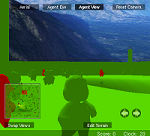Epidemics Unit with Game Programming

The Epidemics unit with game programming differs from the original Epidemics unit in the greater focus on students learning to program.
This unit begins with a sequence of participatory simulations and introductory programming activities to orient students to StarLogo TNG. Then students build an epidemic model from scratch following a step-by-step tutorial. Students then add doctors. Throughout the model construction, the teacher guides the students' use of the two models, encouraging students to make observations and informally inquire about the model. Students then conduct a more structured virtual lab using a model that contains both doctors and hospitals. Students compare the effectiveness of these interventions. Finally, students design and program a game based on the epidemic model.
We'd like to express appreciation to Steve Gordon and his 8th grade students at the Kennedy Middle School in Waltham, MA during school year 2008-2009 for their help in piloting this curriculum.
Epidemics Curriculum with Game Programming At-A-Glance
For a more detailed overview of the curriculum, check out the
teacher overview
.
| Lesson Description | Materials |
|---|---|
| 27 Blind Mice : Students will participate as "agents" in a simulation to explore the differences between global and local communication. | |
| Flocking : Students will explore how patterns are created without relying on centralized control by designing and testing rules for birds flocking. | |
| Introduction to Computer Programming : Students participate in one of several hands-on activity where they must write clear rules for a "dumb" person pretending to be a computer to accomplish a simple task, like putting on a pair of pants or brushing one's teeth. | |
| Termites : Students work in small groups to order a set of commands for a "termite" to build a stack of blocks (representing wood chips). Students first test their program using physical manipulatives and then use StarLogo TNG to test their program with several hundred termites running the program in parallel. | |
| Orientation : Students work in pairs through a 1-1.5 hour worksheet that orients them to the StarLogo TNG interface and takes them step-by-step through constructing a simple program. | |
| PDA Virus Game (Optional): Students play a simulation game using PDA devices (see teacher guide for more information on how to obtain devices and the software). | |
| Virus Research Webquest : Students use the world wide web to research some basic facts about viruses and the spread of diseases. | |
| Build epidemic model, Bring in the Doctors, Hospitals : Students program an epidemic model using a step-by-step tutorial.Then they add doctors and hospitals and see how they affect the model. |
|
| Epidemic model analysis lab : Students run simulations to compare the effects of doctors and hospitals on slowing the spread of a virus. | |
| Game design and programming : Students program a game about the spread of a disease. |
- Login to post comments